MontBell
DOWN SLEEPING WRAP #2 LONG
|
Tester
Information
|
|
| Name:
|
David
Wilkes |
|
E-Mail:
|
amatbrewer@yahoo.com
|
|
Age:
|
52 |
|
Location:
|
Yakima
Washington USA |
|
Gender:
|
M |
|
Height:
|
5'11"
(1.80 m) |
|
Weight:
|
210
lb (90.7 kg) |
|
Biography:
I started
backpacking
in 1995 when I moved to Washington State. Since then, I have
backpacked in all seasons and conditions the Northwest has to
offer. I prefer trips on
rugged trails with plenty of elevation gain. While I continuously
strive to lighten my load, comfort and safety are most important to me.
I have finally managed to get my basic cold weather pack weight, not
including consumables, to under 30 lb (14 kg).
|
|
Product
Information
|
|
Manufacturer:
|
mont-bell Co.,Ltd. |
|
Year
of Manufacture:
|
2020 |
|
Manufacturer’s
Website:
|
https://www.montbell.us/ |
|
MSRP:
|
$399.00
USD
|
Weight:
|
Listed 1lb 9.4 oz. (719 g)
Measured 1lb 8.8 oz. (702 g)
|
Fill weight:
|
15.2 oz. (430 g)
|
Insulation:
| 800 Fill Power EX Down | Fabric:
| 10-denier Ballistic Airlight nylon
POLKATEX® DWR treatment | Compressed size:
| Listed ∅5.9 x 11.7 in. (∅15 x 30 cm), 5.1 L
Measured ~6 x 11in (~15 x 28 cm) | Dimensions:
| Size listed: approx. 53.1 x 84.3 in / 135 x 214 cm
Measured: 50 x 78 in (127 x 198 cm)
Max User Height: 6 ft 6 in / 198 cm | Country of origin:
| VIETNAM |
|
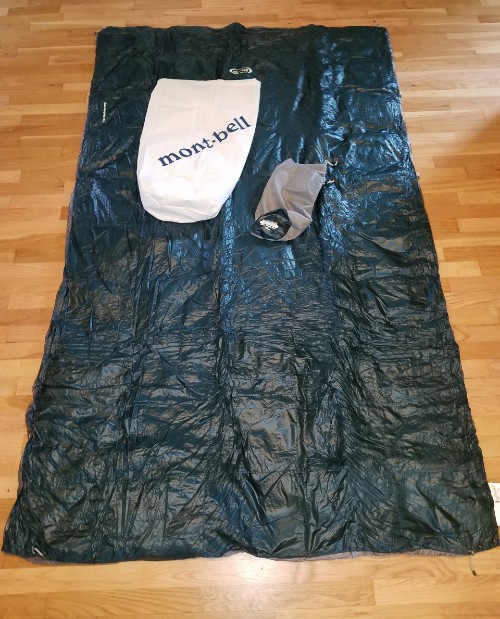
Product Image
|
|
Product
Description:The
MontBell DOWN SLEEPING WRAP #2 (hear after referred to as the
quilt or wrap) is a lightweight down quilt with features allowing it to
also function similar to a sleeping bag. It has plastic snaps and a
drawstring for creating a sleeping bag type foot-box, elastic straps to
secure the middle of the quilt under a sleeping pad and a snap &
drawstring at the head end to reduce drafts. It is intended for
temperatures around 25F (-4C) to 35F (2C).
|
|
Initial
Report
|
|
June 1 2019
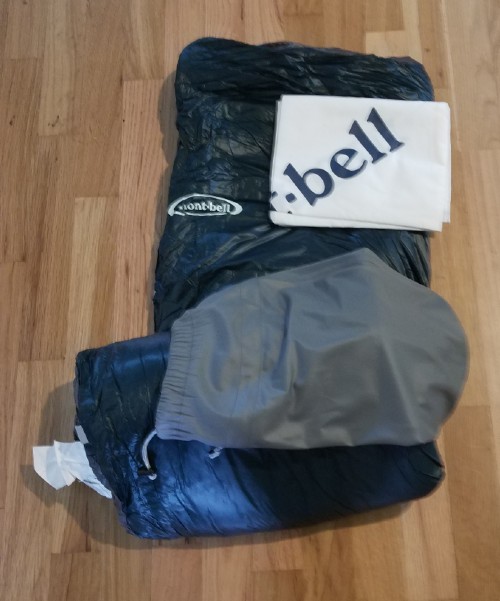 Upon
receiving the wrap I was surprised with how big it was. It is quite
large when uncompressed. My next observation is that the shell material
"10-denier Ballistic Airlight nylon" is lightweight but feels
surprisingly durable. I have other lightweight down items and one
common factor is that the shells are very delicate, but that is not
seem to be the case with this quilt. And while I did find a single
feather on the ground after unpacking, I could see no 'leaking' of
stuffing through the material or at any of the seams. The filling of
the quilt is rather thick, giving the impression that it will be very
warm. I quickly noticed the snaps are plastic. I like this detail as
plastic snaps are much lighter than metal ones, and while they may not
hold as securely as metal, that only means if pulled on the snap should
hopefully separate before putting enough stress on the material to
cause tearing. The two elastic straps each have a small sewn in storage
slot, which is another very nice detail that adds no weight. The quilt
came with a large (I believe to be cotton) storage sack that is of
nicer weave than some of the pillow cases I own (another nice detail)
and a "tapered" stuff sack. I assume the "tapered" refers to the two
draw strings that allow the quilt to be stuffed down to two different
sizes. Not sure why this would be necessary, but I do appreciate the
additional option it affords. If I had to "nitpick" on any missed
opportunity, it would be the seemingly unnecessarily large and thick
tags on the quilt as well as the stuff sack. I would think for an item
that is targeted at people who put a high priority on minimizing
weight/volume, this is a surprising detail to miss. Printing this
directly on the material would be preferable. Since we are not allowed
to alter the items unnecessarily during testing, I will leave the tags.
But if I had purchased this, I would certainly have cut them off
immediately. Upon
receiving the wrap I was surprised with how big it was. It is quite
large when uncompressed. My next observation is that the shell material
"10-denier Ballistic Airlight nylon" is lightweight but feels
surprisingly durable. I have other lightweight down items and one
common factor is that the shells are very delicate, but that is not
seem to be the case with this quilt. And while I did find a single
feather on the ground after unpacking, I could see no 'leaking' of
stuffing through the material or at any of the seams. The filling of
the quilt is rather thick, giving the impression that it will be very
warm. I quickly noticed the snaps are plastic. I like this detail as
plastic snaps are much lighter than metal ones, and while they may not
hold as securely as metal, that only means if pulled on the snap should
hopefully separate before putting enough stress on the material to
cause tearing. The two elastic straps each have a small sewn in storage
slot, which is another very nice detail that adds no weight. The quilt
came with a large (I believe to be cotton) storage sack that is of
nicer weave than some of the pillow cases I own (another nice detail)
and a "tapered" stuff sack. I assume the "tapered" refers to the two
draw strings that allow the quilt to be stuffed down to two different
sizes. Not sure why this would be necessary, but I do appreciate the
additional option it affords. If I had to "nitpick" on any missed
opportunity, it would be the seemingly unnecessarily large and thick
tags on the quilt as well as the stuff sack. I would think for an item
that is targeted at people who put a high priority on minimizing
weight/volume, this is a surprising detail to miss. Printing this
directly on the material would be preferable. Since we are not allowed
to alter the items unnecessarily during testing, I will leave the tags.
But if I had purchased this, I would certainly have cut them off
immediately.
After inspecting the item, I laid out the quilt to
get a feel for its size. The length seems more than adequate for me (I
am 5' 11" / 1.8m tall) and seems more than wide enough despite the fact
that I am not exactly what anyone would describe as "athletic", fat
might be a better adjective. I then used the snaps and draw string to
create the foot box and upon lying down, my dog (~80 lb / 36kg Lab/Pit
mix) immediately climbed on top of me and the quilt. I feared her claws
would shred the shell material but that was unfounded. When I was
finally able to get her off of me and to lie beside me, the quilt
was large enough to cover both of us. As she is a total wimp when it
comes to cold, this is important.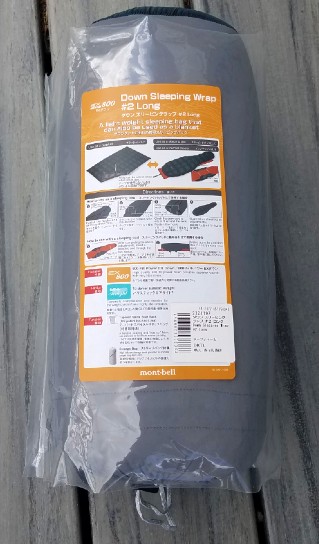
Despite
the quilt's large size it is quite easy to stuff into its stuff sack
and reduces down to about the volume of a 1.5 L (50oz) water bottle.
I
would mention here that I have never used a quilt sleep system before,
but as I am what can be described as a "rotisserie sleeper", I tend to
turn from side, to back to side, etc during the night, sleeping bags
can be difficult for me. I also often use a hammock, which is not
especially compatible with a sleeping bag. So I have long wanted to
make the switch (at least for warmer weather) to a quilt.
Likes:
- Large and thick but light
- Does not appear to be fragile
- Some nice details that add to functionality but not weight
Opertunities:
- Eliminate the large thick tags
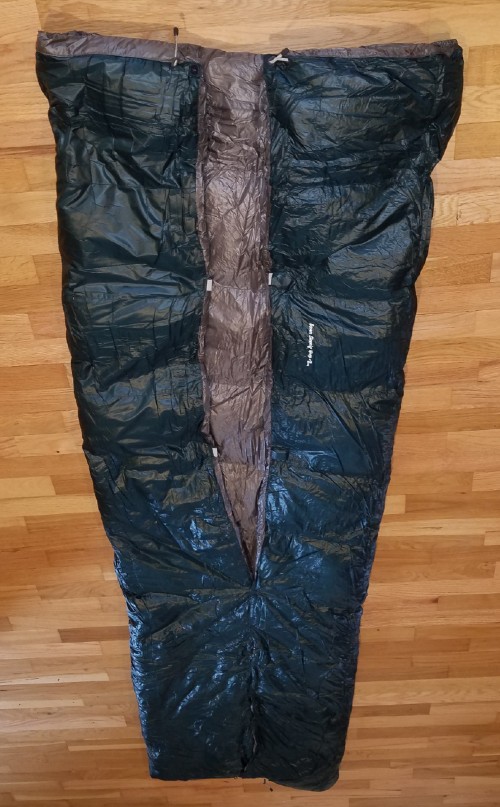 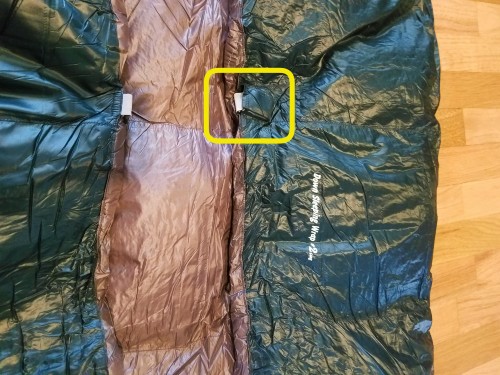
|
|
Field Report
|
| August 13 2020 |
Use:
- Backpacking 3 nights - Pacific Crest Trail (PCT)
Central Washington Cascades - nighttime lows ~40F (4.5C) - 28 mi/ 45 km
- elevations between 4000-6000' / 1219-1829 m
- Camping 3 nights Oregon Coast - inside a camper - nighttime lows ranged from about 40F- 50F (4.5C-10C)
- Camping 3 nights Bend Oregon - inside a camper - nighttime lows ranged from about 40F- 50F (4.5C-10C)
This
has been a trying time for gear testing. All of my plans have been
either canceled or indefinitely postponed. Even trail work has been
either canceled or severely restricted (as of now we can scout but no
work involving tools is allowed and nothing that involves overnight
stays). While some of the forests are open, all the public campgrounds,
parks, and such are closed. Some private campgrounds are open but have
lots of extra rules and restrictions (e.g. must be fully
self-contained, no tents, and public facilities such as bathrooms are
closed). My backpacking trip was something I could squeeze in, and kind
of skirts the edges of what is allowed. And we had to travel out of the
county in order to get in what little camping we have managed.
Spoiler
alert: Based on my use of this quilt so far I doubt I will go back to
using a sleeping bag except for trips where the temperatures are
expected to be too cold for this quilt (e.g. winter).
While
trying out the various configurations along with my sleeping pad
(~3"/8cm thick insulated inflatable pad) I discovered the buckles on
the elastic straps could easily come off...because one of them did.
Luckily this was at home and I was able to locate it. The ends of the
straps have no loop or other way to prevent the buckle from sliding off
the ends of the elastic strap. Given the quality of this product and
the otherwise high attention to detail, it is surprising they missed
this. I contacted the manufacturer asking if this was by design or an
issue with my item, and received a quick reply: "The straps are not
sewn into a loop or hemmed in any way, so you may want to fold and sew
a small piece of the strap at the end to keep the buckle from sliding
off. We will send your suggestion on to our team, thank you and
have a great day!"
I sewed small loops into the end of each strap and I believe this will resolve the issue.
I
verified that the quilt was large enough to completely cover me
regardless of wether it is fully open or the foot box entirely closed.
The elastic straps are long enough that I can easily wrap them around
my sleeping pad and the quilt is not tight or constricting in any way.
My
first night backpacking was after a few hours of hiking in the rain. I
had protected the quilt and other key gear from getting wet but I was
soaked (rain and sweat). I set up my tent in light rain so the interior
was not entirely dry. The temperatures were expected to stay well above
freezing so I closed the foot-box of the quilt (I tend to get very cold
feet) but just draped the quilt over my sleeping pad without using the
straps. I tend to be a very active ("rotisserie") sleeper and turn over
often. During the night I had to adjust the quilt a few times when I
turned over, but I found it be far less than I would normally fuss with
a mummy sleeping bag.
NOTE: during this trip I wore a thin base
layer and warm socks to sleep in. This is my normal practice unless I
am expecting very warm nighttime temperatures.
The other two
nights I wrapped the lowest of the two elastic straps around my
sleeping mat with the buckle positioned for its full length. This
prevented the quilt from moving regardless of how much I did. I would
note that this was a brutal trip and by the time I went to bed in the
evening every part of my body hurt and I was unable to find any
position that was comfortable, so I tossed and turned even more than
normal. I would also mention that due to recent rains and lots of
remaining snow, the humidity was higher than normal for this area/time
of year. The first morning I found some moisture on the exterior of the
quilt's foot box and had no opportunity to dry it that day so it was
still damp when I set up camp that night. The following morning as far
as I could tell the quilt was fully dry.
While camping I used
the quilt as an alternative blanket. Between my wife and dog (82lb/37kg
Lab Pit mix) I often lose the fight for the blanket. So I simply draped
the quilt over me, which worked quite well, and I wish I had thought of
it sooner.
I also have wrapped up in the quilt at home for
watching TV in our chilly basement and for a couple of chilly nights
when sitting out on the deck. This quilt is quite warm and comfortable
even against bare skin.
I like that this quilt is very warm for
its weight, versatile, and packs down very small. The straps seem to
work well to hold the quilt in place without making it restrictive.
Aside for the above issue with the straps I have found no problems. If
there was anything that could make this better it would be an
additional set of snaps allowing me to wear it like a cape around camp
in place of my down puffy, thereby further reducing my gear weight/bulk.
|
Long Term Report
|
| October 19 2020 |
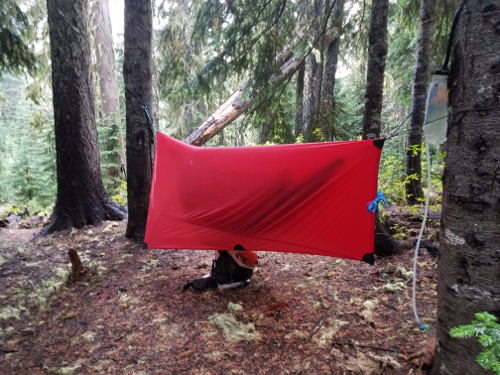 Use: Use:
Backpacking
– 1 night, Central Washington Cascades, Dear Lake, elevation 5219ft / 1591m, light rain/wind, nighttime low about 35F ( 2C)
Despite
most of the local trails parks and forests being closed due to a
combination of COVID-19, fires, and high fire risk, I wanted to try the
quilt in my hammock before the end of the test series. I finally
managed to get in one more night of backpacking at a local trail once
they got the road open. (The fires in the area were only partially
contained.) The weather was intermittent rain and light wind which was
good for getting the fires under control but not exactly ideal for
backpacking, and while it was comfortable during the day the night was
colder than I had expected. As such I was not quite prepared but it did
give me a good idea of how warm this quilt is.
For cool weather
I have a homemade down under-quilt, which I augment with an insulated
pad for cold weather, but as I was not expecting it to be this cold I
only packed the under quilt and the Down Sleeping Wrap. The first
couple of hours in the hammock were uncomfortable, I could feel the
heat being sucked out of me through the under quilt with every breeze,
however when the breeze stopped the I was able to warm up quickly,
which I attribute to the warmth of the Sleeping Wrap. The wind tapered
off and by early morning, while it was rather cold there was no wind so
my bottom side was only moderately cold while the rest of my body was
quite warm and I managed to finally get a few hours of fitful sleep.
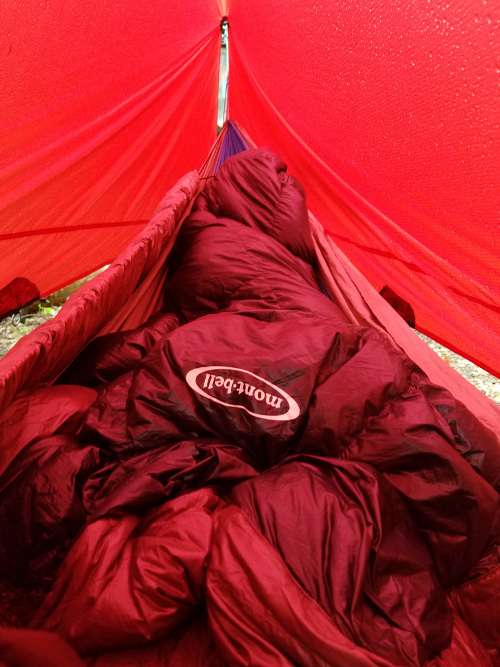 I
am quite happy with the way the quilt worked in the hammock. I was able
to close off the foot box which held the quilt in place despite my
constant repositioning to warm up the coldest part of my bottom. The
length and width of the quilt allowed me to get full coverage and even
wrap some of it under me, not that compressed down provides much
insulation but I was willing to take any insulation I could get. Had I
a better under quilt or my insulated pad, I have no doubt I would have
been comfortable and warm in much lower temperatures. I
am quite happy with the way the quilt worked in the hammock. I was able
to close off the foot box which held the quilt in place despite my
constant repositioning to warm up the coldest part of my bottom. The
length and width of the quilt allowed me to get full coverage and even
wrap some of it under me, not that compressed down provides much
insulation but I was willing to take any insulation I could get. Had I
a better under quilt or my insulated pad, I have no doubt I would have
been comfortable and warm in much lower temperatures.
At the conclusion of the test I examined the Sleeping Wrap and can find no indications of wear or potential failure points.
Considering
future post-test use, now that we are getting some snow in the
mountains, I look forward to trying the quilt out for some subfreezing
conditions. And I have no doubt that besides maybe the coldest of
conditions, I will be getting very little use out of my sleeping bags,
as I am now a quilt convert.
|
This
concludes
my Report.
I would like to thank the folks at MontBell and BackpackGearTest.org
for the opportunity to test this product.
|
|




